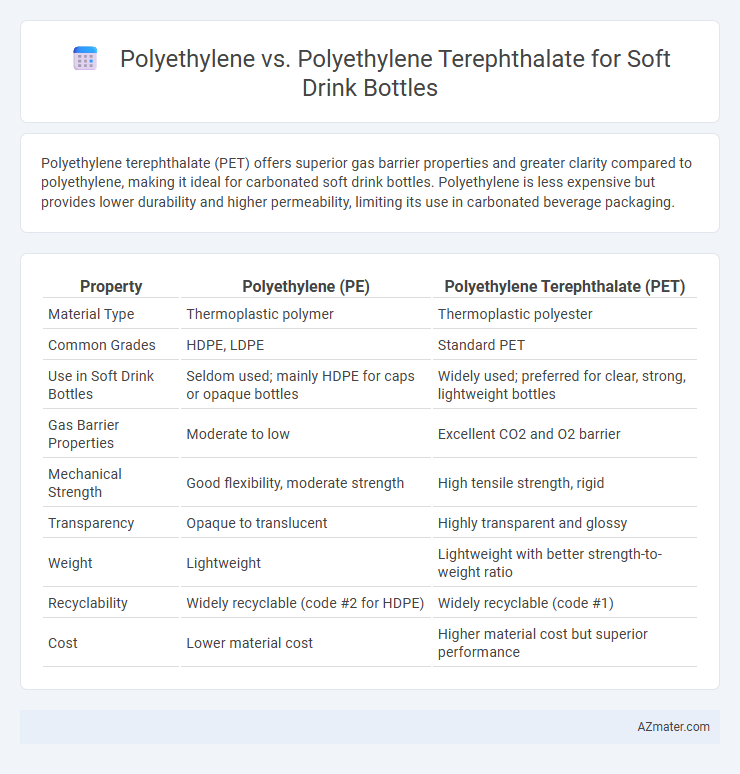Polyethylene terephthalate (PET) offers superior gas barrier properties and greater clarity compared to polyethylene, making it ideal for carbonated soft drink bottles. Polyethylene is less expensive but provides lower durability and higher permeability, limiting its use in carbonated beverage packaging.
Table of Comparison
| Property | Polyethylene (PE) | Polyethylene Terephthalate (PET) |
|---|---|---|
| Material Type | Thermoplastic polymer | Thermoplastic polyester |
| Common Grades | HDPE, LDPE | Standard PET |
| Use in Soft Drink Bottles | Seldom used; mainly HDPE for caps or opaque bottles | Widely used; preferred for clear, strong, lightweight bottles |
| Gas Barrier Properties | Moderate to low | Excellent CO2 and O2 barrier |
| Mechanical Strength | Good flexibility, moderate strength | High tensile strength, rigid |
| Transparency | Opaque to translucent | Highly transparent and glossy |
| Weight | Lightweight | Lightweight with better strength-to-weight ratio |
| Recyclability | Widely recyclable (code #2 for HDPE) | Widely recyclable (code #1) |
| Cost | Lower material cost | Higher material cost but superior performance |
Introduction to Soft Drink Bottle Materials
Soft drink bottles primarily use Polyethylene Terephthalate (PET) and Polyethylene (PE) due to their distinct material properties. PET offers high strength, excellent gas barrier performance, and clarity, making it ideal for carbonated beverages requiring prolonged shelf life. In contrast, Polyethylene, especially High-Density Polyethylene (HDPE), provides superior chemical resistance and impact toughness but has lower transparency and gas barrier capabilities compared to PET.
Overview of Polyethylene (PE)
Polyethylene (PE), a versatile thermoplastic polymer, is widely used in soft drink bottle production due to its excellent chemical resistance and flexibility. Its low-cost manufacturing, combined with high impact strength and moisture barrier properties, makes PE a preferred choice for lightweight, durable packaging. While it does not provide the same level of gas barrier as Polyethylene Terephthalate (PET), PE remains valuable for cost-effective applications requiring less stringent preservation conditions.
Overview of Polyethylene Terephthalate (PET)
Polyethylene Terephthalate (PET) is a lightweight, strong, and transparent thermoplastic polymer extensively used for soft drink bottles due to its excellent gas barrier properties and high impact resistance. Its molecular structure provides superior carbonation retention, preventing CO2 loss and preserving the beverage's freshness over time compared to polyethylene (PE). PET also offers recyclability advantages, commonly accepted in recycling programs, thereby supporting sustainability in beverage packaging industries.
Key Properties: PE vs PET
Polyethylene (PE) offers excellent flexibility and impact resistance, making it suitable for soft drink bottles that require durability and lightweight characteristics. Polyethylene Terephthalate (PET) provides superior gas barrier properties, high clarity, and rigidity, ensuring better carbonation retention and visual appeal for beverages. PET's resistance to moisture and chemical degradation also enhances shelf life, while PE is more cost-effective but less efficient in preserving carbonation and preventing gas permeation.
Barrier Performance: Gas and Moisture Protection
Polyethylene Terephthalate (PET) exhibits superior barrier performance against gases like oxygen and carbon dioxide compared to Polyethylene (PE), making it ideal for preserving soft drink carbonation and freshness. PET's crystalline structure significantly reduces gas permeability, whereas PE allows higher gas transmission, risking product spoilage. Both materials offer moisture protection, but PET provides a more balanced barrier to maintain beverage quality and shelf life.
Mechanical Strength and Durability
Polyethylene Terephthalate (PET) exhibits superior mechanical strength and durability compared to Polyethylene (PE), making it the preferred choice for soft drink bottles. PET offers high tensile strength and excellent impact resistance, ensuring better shape retention and protection under stress during transportation and handling. In contrast, Polyethylene, while flexible and lightweight, has lower mechanical strength and is more prone to deformation and wear, limiting its effectiveness for durable, pressure-resistant soft drink containers.
Food Safety and Chemical Compatibility
Polyethylene terephthalate (PET) is widely preferred for soft drink bottles due to its excellent food safety profile and strong chemical resistance, preventing leaching of harmful substances into beverages. Polyethylene (PE), while safe for food contact, exhibits lower barrier properties and higher permeability to gases, which can affect beverage freshness and flavor over time. PET's superior structural stability and resistance to carbonation make it the optimal choice for maintaining chemical compatibility and product integrity in soft drink packaging.
Environmental Impact and Recyclability
Polyethylene (PE) and Polyethylene Terephthalate (PET) differ significantly in environmental impact and recyclability for soft drink bottles. PET offers higher recycling rates due to widespread infrastructure and produces bottles with lower weight, reducing transportation emissions, whereas PE generally has lower recycling rates and competes less effectively in closed-loop recycling systems. The biodegradability of neither plastic is significant, but PET's clearer recycling streams minimize landfill waste and encourage circular economy practices in beverage packaging.
Cost and Manufacturing Considerations
Polyethylene (PE) offers lower material costs and simpler manufacturing processes compared to Polyethylene Terephthalate (PET), making it economically favorable for soft drink bottles with basic requirements. PET provides superior gas barrier properties and durability but entails higher production expenses due to complex polymerization and injection molding techniques. Cost-efficiency in soft drink packaging depends on balancing PE's affordability with PET's performance benefits in preserving carbonation and shelf life.
Conclusion: Choosing the Right Material for Soft Drink Bottles
Polyethylene Terephthalate (PET) offers superior clarity, strength, and gas barrier properties, making it the preferred choice for soft drink bottles requiring extended shelf life and carbonation retention. Polyethylene (PE) provides better flexibility and impact resistance but lacks the necessary barrier qualities for carbonated beverages. For optimal packaging performance, PET stands out as the ideal material due to its balance of durability, clarity, and preservation capabilities.

Infographic: Polyethylene vs Polyethylene Terephthalate for Soft Drink Bottle
 azmater.com
azmater.com